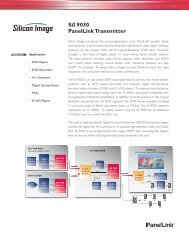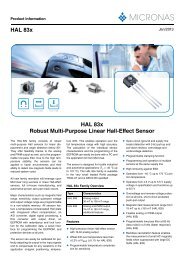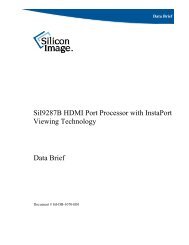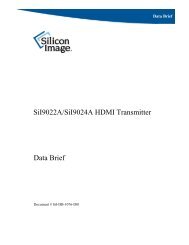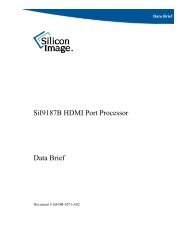D a t a S h e e t - SemiconductorStore.com
D a t a S h e e t - SemiconductorStore.com
D a t a S h e e t - SemiconductorStore.com
You also want an ePaper? Increase the reach of your titles
YUMPU automatically turns print PDFs into web optimized ePapers that Google loves.
• Radio transmitter enable/disable – a simple <strong>com</strong>mand connects to a dedicated<br />
hardware switch that determines whether the radio can transmit<br />
• The firmware can read the voltage on a pair of the chip’s external pins. This is normally<br />
used to build a battery monitor, using either VM or host code<br />
• A block of BCCMD <strong>com</strong>mands provides access to the chip’s “persistent store”<br />
configuration database (PS). The database sets the device’s Bluetooth address, Class<br />
of Device, radio (transmit class) configuration, SCO routing, LM, USB and DFU<br />
constants, etc.<br />
• A UART “break” condition can be used in three ways:<br />
• Presenting a UART break condition to the chip can force the chip to perform a hardware<br />
reboot<br />
• Presenting a break condition at boot time can hold the chip in a low power state,<br />
preventing normal initialization while the condition exists<br />
• With BCSP, the firmware can be configured to send a break to the host before sending<br />
data – normally used to wake the host from a deep sleep state<br />
• The DFU standard has been extended with public/private key authentication, allowing<br />
manufacturers to control the firmware that can be loaded onto their Bluetooth modules<br />
• A modified version of the DFU protocol allows firmware upgrade via the chip’s UART<br />
• A block of “radio test” or BIST <strong>com</strong>mands allows direct control of the chip’s radio. This<br />
aids the development of modules’ radio designs, and can be used to support Bluetooth<br />
qualification.<br />
• Virtual Machine (VM). The firmware provides the VM environment in which to run<br />
application-specific code. Although the VM is mainly used with BlueLab and “RFCOMM<br />
builds” (alternative firmware builds providing L2CAP, SDP and RFCOMM), the VM can<br />
be used with this build to perform simple tasks such as flashing LED’s via the chip’s<br />
PIO port.<br />
• Hardware low power modes: shallow sleep and deep sleep. The chip drops into modes<br />
that significantly reduce power consumption when the software goes idle.<br />
• SCO channels are normally routed via HCI (over BCSP). However, up to three SCO<br />
channels can be routed over the chip’s single PCM port (at the same time as routing<br />
any remaining SCO channels over HCI).<br />
• Co-operative existence with 802.11b/g chipsets. The device can be optionally<br />
configured to support a number of different co-existence schemes including:<br />
o<br />
o<br />
o<br />
TDMA - Bluetooth and WLAN avoid transmitting at the same time.<br />
FDMA - Bluetooth avoids transmitting within the WLAN channel<br />
Combination TDMA & FDMA - Bluetooth avoids transmitting in the WLAN<br />
channel only when WLAN is active.<br />
• Please refer to separate documentation for full details of the co-existence schemes that<br />
CSR supports.<br />
Notes:<br />
1. Supports basic data rate up to 723.2kbps asymmetric, maximum allowed by<br />
Bluetooth v2.0 + EDR specification<br />
2. WT12 supports all <strong>com</strong>binations of active ACL and SCO channels for both Master<br />
and<br />
3. Always refer to the Firmware Release Note for the specific functionality of a<br />
particular build.<br />
37


